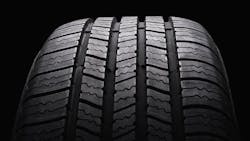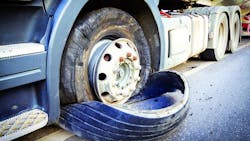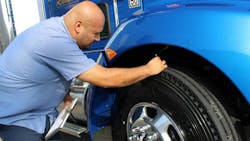Checking and maintaining proper air pressure for truck and trailer tires is probably one of the more irritating and time-consuming maintenance tasks faced by drivers and fleet managers alike. And that’s doubly true for highway tractor drive axles and trailer axles spec’d in traditional “dual-wheel” configurations, as checking and maintaining air pressure on the inner dual tire position is a physically taxing chore in numerous ways.
All the stretching and straining required for reaching the valve stem on an inner dual tire sometimes convinces drivers to skip this important step—required by pre-inspection protocols—or use dubious methods for attaining the air pressure level within a tire, e.g., “thumping” tires with a baton or other such object.
Ralph Dimenna, COO of Michelin Americas Truck Tires, a division of global tire maker Michelin, noted that a tire that is 10% underinflated will lose 10% in tread wear and will come out of service quicker. He added that a tire that is 20% below the optimal air pressure is considered a flat tire and warned that tires operated in such underinflated conditions will experience “casing fatigue” that could lead to a catastrophic failure or a zipper rupture.
“If the tire has been run 20% underinflated, it should be removed from the vehicle and scrapped,” Dimenna stressed.
Under guidelines established by the Federal Motor Carrier Safety Administration under its Compliance Safety Accountability program, a tire that is found to be operating with less than 50% of its maximum pressure is considered to be in an out-of-service condition, putting a truck or tractor-trailer on the side of the road until it can be replaced.
The reason commercial vehicles are sidelined in such situations is that underinflated tires experience higher temperatures and greater stress, thus presenting an increased risk of failure, explained Jon Intagliata, product manager for tire pressure monitoring systems at Bendix Commercial Vehicle Systems.
“Industry research has indicated that about 90% of tire blowouts can be traced to under-inflation, and almost half of all emergency service road calls are tire-related,” he added.
Intagliata noted that research by the Technology & Maintenance Council, which is an arm of the American Trucking Associations trade group, found that tire under-inflation of just 20% results in a 30% reduction in tire life.
“Another pressure-related issue is that of dual-tire imbalance,” he added. “When you’ve got a pair of tires side-by-side on an axle, if one is running at a lower pressure, it’s essentially got a different circumference than its neighbor. This means that as the axle rotates, that tire’s going to drag and experience excessive wear, increasing the chance that it’s going to fail prematurely.”
There’s also another safety aspect of under-inflation to consider as well beyond just a heightened risk of tire blowouts, he emphasized.
“Advanced safety technologies really do rely on maintenance of basic components like tires to ensure best performance on the road,” Intagliata said.
“If you’ve invested in systems that help prevent or mitigate forward collisions or that intervene through braking power to help prevent rollovers, the last thing you want is to reduce their effectiveness through something as easily preventable as poorly inflated tires,” he pointed out.
Brian Buckham, general manager-product marketing for Goodyear Tire & Rubber Co., stressed that while it’s difficult to predict what will happen to a tire when it’s rolling down the highway, preventive maintenance is the one thing that helps ensure tires are in optimal condition before they hit the asphalt.
“Like other truck components, tires require post-installation maintenance—and good truck tire maintenance starts with frequent air pressure checks,” he emphasized.
“Generally speaking, maintaining proper tire inflation pressure is probably the single most effective maintenance practice that a fleet can employ to positively impact tire wear, casing life and overall tire performance,” Buckham noted. “As such, both over- and under-inflation should be avoided. Under-inflation can be particularly harmful, as running a truck tire under-inflated for a long period can induce excessive heat buildup.”
In fact, a study conducted by the University of Michigan Transportation Research Institute eight years ago—an effort sponsored by the National Highway Traffic Safety Administration—discerned that improper tire maintenance and operational issues were the root cause of 32% of failed truck tires found on the roadside.
The same study found the two other leading causes of tire debris on the road are road hazards and excessive heat, noted Jason Evans, director of store operations for GCR Tires & Service.
Heat
“Heat is a tire’s worst enemy,” he stressed. “Chemical reactions increase exponentially with temperature. As such, heat accelerates the tire-aging process, which is why it is so important to minimize the amount of heat a tire sees both in service and in storage.”
Michelin’s Dimenna added that when an under-inflated tire heats up, the casing integrity changes due to that heat buildup.
“This can lead to separation [between the casing and tread] and chemical breakdown,” he explained. “Heat magnifies the issue and tires fail because they cannot be cooled by the ambient temperatures around them.”
Yet GCR’s Evans also emphasized that cold temperatures can damage a tire, too.
“Depending on a tire’s compounding and how low the ambient temperature reaches, you can get what is commonly referred to as ‘cold weather cracking,’” he noted. “When a tire is exposed to extreme cold temperatures, tire compounds can lose their elasticity and become brittle. Tires also wear faster when the temperature is lower as compounds become stiff and less pliable.”
Temperature is critical in more ways than one to ensuring long, usable life for truck and trailer tires, pointed out Tom Clauer, corporate manager of commercial and OTR product planning for the U.S. division of Yokohama Tire.
“Every [tire] manufacturer will tell you to check the air pressure on a cold tire; not a hot or ‘recently ran’ tire,” he said. “As a tire moves, there is a certain amount of resistance that is evident. This resistance comes from flexing and the various components [of a tire; its tread, casing, and sidewall] moving against and with each other.
“This generates heat, which will increase the air pressure inside the chamber of the tire.”
Clauer noted that a commercial tire can handle a certain amount of increased air pressure, but that the key is to not allow the air pressure to drop below its rated capacity for the load.
“We need to remember that a tire is not carrying the load; it is only a vessel to contain the air pressure, which does carry the load,” he explained.
Cold
And as is often the case in trucking, it’s the “little things” that can make a big difference when it comes to maintaining proper tire pressure. Take, for example, tire valve stem caps.
“All valves should be capped only with either metal or flow-through caps—no plastics,” Clauer said. “The only exceptions would be if you are using automatic air or equalizing systems.”
Drivers and fleet managers need to remember to always allow a tire to cool for several hours or overnight in order to get an accurate air pressure measurement, he emphasized.
“Extremely cold climates can create just the opposite results and bring in other issues,” he added. “In extreme cold climates, air pressure should be checked in a controlled environment. If possible, allow the tire(s) to reach a temperature above 32 degrees [Fahrenheit] in order to get an accurate pressure measurement.”
Other challenges that can affect tire performance in extreme cold environments include condensation in both ambient air and in the compressed air found within a commercial vehicle’s air supply system.
“This can gather in the [tire air] valve core, freeze, expand and actually allow the core to open and release air,” Clauer explained, leading to tire deflation.
Goodyear’s Buckham added that fleets should make it standard practice to check inflation levels at least once a week, if not more often when possible.
“Also keep in mind that ambient temperature can impact a tire’s inflation levels,” he said. “As a general rule of thumb, inflation pressure can drop one pound [per square inch] for every 10-degree [Fahrenheit] decrease in ambient temperature.”
Some fleets also employ the extra step of using an automatic tire inflation system to monitor and “top off” tire pressure levels as needed, added Buckham.
“In addition to tire pressure checks, we strongly recommend that fleets perform regular visual and tactile inspections of their tires,” he emphasized. “Things to check for include unusual wear patterns, plus cracks, cuts, bulges and blisters, all of which should be addressed immediately.”
GCR’s Evans noted that while such “visual cues” regarding tire condition are important, proper tire maintenance and safety are about more than meets the naked eye.
“We advise our customers to conduct thorough tire assessments before each haul, which includes checking inflation pressure at each wheel position, measuring inflation pressure, and tracking mileage on tires,” he explained.
Additionally, Evans said fleets should regularly mount/dismount wheels and check truck alignment to help catch any non-visible issues before they become unplanned downtime.
“It’s also critical for fleets to work with their dealer/service partner to schedule regular tire inspection checks that are conducted by a tire professional,” he pointed out.
Alignment
Other critical tactics can be used to not only ensure better overall tire health but reduce the risk of premature failure as well.
“Tire alignment is important,” Michelin’s Dimenna said. “Many tire problems can be traced to mechanical conditions in the vehicle. Therefore, to obtain maximized tire performance, vehicles must be properly maintained—and that includes tire alignment.”
He noted that “alignment” refers not only to the various angles of the steer axle geometry, but also to the tracking of all axles on a vehicle including the trailer.
“The dual purpose of proper alignment is to minimize tire wear and to maximize predictable vehicle handling and driver control,” he explained. “Toe misalignment is the number one cause of steer tire irregular wear, followed by rear axle skew, also known as parallelism or thrust.”
Dimenna also pointed out that proper tire matching and rotation are important too. “Beware mixing [types of] tires on your vehicle, especially across an axle,” he warned. “Try to match tires with the same tread depths, same tread patterns, and same height or diameter.”
At the end of the day, however, putting an emphasis on maintaining proper tire inflation pressure is perhaps the single more effective tactic to not only reduce the risk of catastrophic blowouts but also as a way to ensure all other safety systems on a truck and trailer work to their utmost capability, too, according to Bendix’s Intagliata.
“If you think of the approach to safety system maintenance like a hierarchy, tire upkeep—much like the actual tires on a vehicle—is the foundation upon which other systems rest,” he said.
“Getting the best performance from drum brakes, air disc brakes, full-stability systems, and advanced driver assistance technologies requires tires that are in good shape and at the correct inflation pressure,” Intagliata emphasized.
“Tire inflation is just about the most basic form of maintenance there is, but not paying the right attention to it can have serious effects on several levels of vehicle and fleet safety,” he stressed.
TIRE CARE: FROM START TO FINISH
Reducing the risk of premature failure or a catastrophic failure for either a truck or trailer tire isn’t solely about maintaining proper inflation pressure, noted Jason Evans, director of store operations for GCR Tires & Service. In fact, the process starts before a fleet even buys its tires.
—Select the right tire for the job, considering the proper tire size, load-carrying capacity, speed capability, and service type.
—Inspect tires frequently for damage such as cuts, cracks, bulges, and penetrations.
—Track mileage and measure inflation pressure to monitor tire performance. (Note: tire under-inflation by as little as 10% can result in a 1.5% drop in fuel economy, according to data analyzed by TMC.)
—Check tread depth at each wheel position and watch for mismatching tread depths to avoid scrub. Scrub-out is caused when one tire has a larger circumference or tread depth. This leads to irregular wear and can impact fuel economy.
—Set and maintain proper cold inflation pressures. Cold inflation pressure is the inflation pressure of tires before they are driven.
—Abide by the tire’s maximum recommended speed, which may be lower than posted speed limits.
Tom Clauer, corporate manager of commercial and OTR product planning for Yokohama Tire, adds in a few other “telltale warning signs” that may indicate a tire could be close to suffering a premature failure. Those include sidewall discoloration, cuts, scrapes, and other damage; irregular wear; and debris in the tread.
“When it comes to tread condition, ‘shiny’ is not good, as that may indicate nail heads or bolts are stuck in it,” he explained. “Look for and dislodge any debris stuck in the [tread] grooves such as rocks that the tires cannot eject. If they are not removed, they could continue to work at the tread base and groove walls and pose potential casing damage if allowed to get through the base and into the steel belts.”
About the Author
Sean Kilcarr
Editor in Chief
Sean Kilcarr is a former longtime FleetOwner senior editor who wrote for the publication from 2000 to 2018. He served as editor-in-chief from 2017 to 2018.


